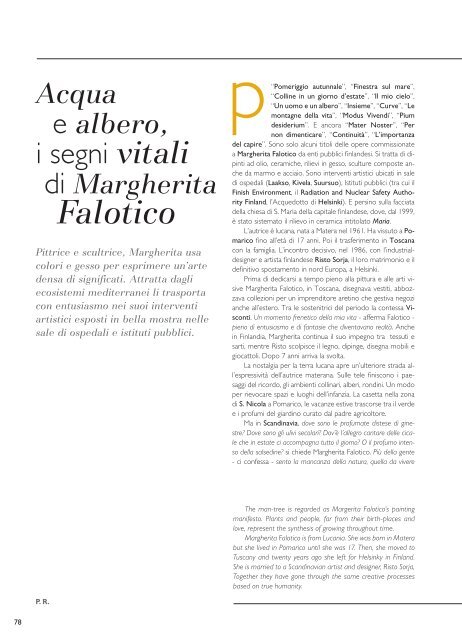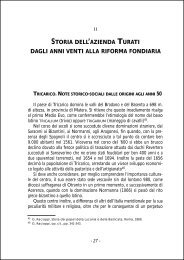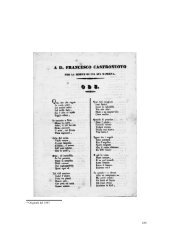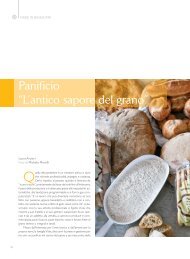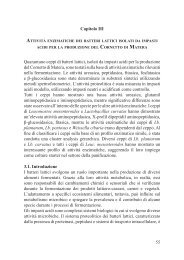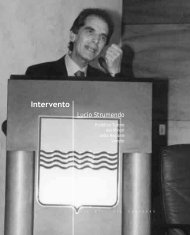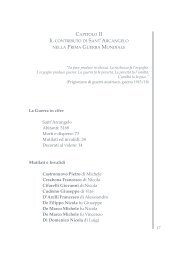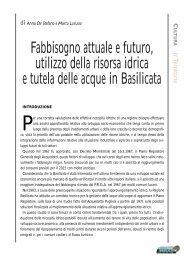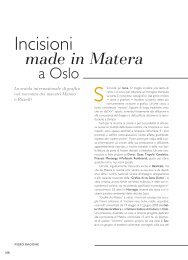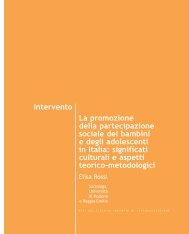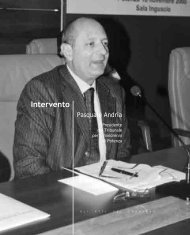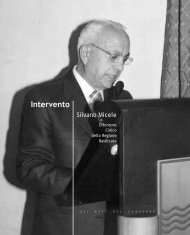Acqua e albero, i segni vitali di Margherita Falotico Piero Ragone
Acqua e albero, i segni vitali di Margherita Falotico Piero Ragone
Acqua e albero, i segni vitali di Margherita Falotico Piero Ragone
You also want an ePaper? Increase the reach of your titles
YUMPU automatically turns print PDFs into web optimized ePapers that Google loves.
<strong>Acqua</strong><br />
e <strong>albero</strong>,<br />
i <strong>segni</strong> <strong>vitali</strong><br />
<strong>di</strong> <strong>Margherita</strong><br />
<strong>Falotico</strong><br />
Pittrice e scultrice, <strong>Margherita</strong> usa<br />
colori e gesso per esprimere un’arte<br />
densa <strong>di</strong> significati. Attratta dagli<br />
ecosistemi me<strong>di</strong>terranei li trasporta<br />
con entusiasmo nei suoi interventi<br />
artistici esposti in bella mostra nelle<br />
sale <strong>di</strong> ospedali e istituti pubblici.<br />
p“Pomeriggio autunnale”, “Finestra sul mare”,<br />
“Colline in un giorno d’estate”, “Il mio cielo”,<br />
“Un uomo e un <strong>albero</strong>”, “Insieme”, “Curve”, “Le<br />
montagne della vita”, “Modus Viven<strong>di</strong>”, “Pium<br />
desiderium”. E ancora “Mater Noster”, “Per<br />
non <strong>di</strong>menticare”, “Continuità”, “L’importanza<br />
del capire”. Sono solo alcuni titoli delle opere commissionate<br />
a <strong>Margherita</strong> <strong>Falotico</strong> da enti pubblici finlandesi. Si tratta <strong>di</strong> <strong>di</strong>pinti<br />
ad olio, ceramiche, rilievi in gesso, sculture composte anche<br />
da marmo e acciaio. Sono interventi artistici ubicati in sale<br />
<strong>di</strong> ospedali (Laakso, Kivela, Suursuo), Istituti pubblici (tra cui il<br />
Finish Environment, il Ra<strong>di</strong>ation and Nuclear Safety Authority<br />
Finland, l’Acquedotto <strong>di</strong> Helsinki). E persino sulla facciata<br />
della chiesa <strong>di</strong> S. Maria della capitale finlandese, dove, dal 1999,<br />
è stato sistemato il rilievo in ceramica intitolato Maria.<br />
L’autrice è lucana, nata a Matera nel 1961. Ha vissuto a Pomarico<br />
fino all’età <strong>di</strong> 17 anni. Poi il trasferimento in Toscana<br />
con la famiglia. L’incontro decisivo, nel 1986, con l’industrialdesigner<br />
e artista finlandese Risto Sorja, il loro matrimonio e il<br />
definitivo spostamento in nord Europa, a Helsinki.<br />
Prima <strong>di</strong> de<strong>di</strong>carsi a tempo pieno alla pittura e alle arti visive<br />
<strong>Margherita</strong> <strong>Falotico</strong>, in Toscana, <strong>di</strong>segnava vestiti, abbozzava<br />
collezioni per un impren<strong>di</strong>tore aretino che gestiva negozi<br />
anche all’estero. Tra le sostenitrici del periodo la contessa Visconti.<br />
Un momento frenetico della mia vita - afferma <strong>Falotico</strong> -<br />
pieno <strong>di</strong> entusiasmo e <strong>di</strong> fantasie che <strong>di</strong>ventavano realtà. Anche<br />
in Finlan<strong>di</strong>a, <strong>Margherita</strong> continua il suo impegno tra tessuti e<br />
sarti, mentre Risto scolpisce il legno, <strong>di</strong>pinge, <strong>di</strong>segna mobili e<br />
giocattoli. Dopo 7 anni arriva la svolta.<br />
La nostalgia per la terra lucana apre un’ulteriore strada all’espressività<br />
dell’autrice materana. Sulle tele finiscono i paesaggi<br />
del ricordo, gli ambienti collinari, alberi, ron<strong>di</strong>ni. Un modo<br />
per rievocare spazi e luoghi dell’infanzia. La casetta nella zona<br />
<strong>di</strong> S. Nicola a Pomarico, le vacanze estive trascorse tra il verde<br />
e i profumi del giar<strong>di</strong>no curato dal padre agricoltore.<br />
Ma in Scan<strong>di</strong>navia, dove sono le profumate <strong>di</strong>stese <strong>di</strong> ginestre?<br />
Dove sono gli ulivi secolari? Dov’è l’allegro cantare delle cicale<br />
che in estate ci accompagna tutto il giorno? O il profumo intenso<br />
della salse<strong>di</strong>ne? si chiede <strong>Margherita</strong> <strong>Falotico</strong>. Più della gente<br />
- ci confessa - sento la mancanza della natura, quella da vivere<br />
The man-tree is regarded as Margerita <strong>Falotico</strong>’s painting<br />
manifesto. Plants and people, far from their birth-places and<br />
love, represent the synthesis of growing throughout time.<br />
<strong>Margherita</strong> <strong>Falotico</strong> is from Lucania. She was born in Matera<br />
but she lived in Pomarico until she was 17. Then, she moved to<br />
Tuscany and twenty years ago she left for Helsinky in Finland.<br />
She is married to a Scan<strong>di</strong>navian artist and designer, Risto Sorja,<br />
Together they have gone through the same creative processes<br />
based on true humanity.<br />
P. R.<br />
78
M NDO<br />
BASILICATA<br />
con il contatto fisico, camminandoci sopra, toccando, annusando il<br />
profumo dei fiori o del mare. Avvertendo l’odore della terra appena<br />
arata o <strong>di</strong> quella bruciata dal sole.<br />
È da almeno 25 anni che non torna a Pomarico, che non<br />
vede i suoi. Telefona, comunica via web, invia foto. Pensa e<br />
scrive correntemente in italiano. Ma la sua profonda ferita rimane<br />
aperta. Allora il rapporto con la pittura si è fatto più regolare,<br />
intenso, quasi a compensare queste carenze.<br />
Il marito Risto la segue. Hanno fatto insieme <strong>di</strong>versi interventi.<br />
Dalla pittura alla materia, <strong>Margherita</strong>, da un po’ <strong>di</strong> tempo,<br />
impasta e modella il gesso bianco. Poi cerca <strong>di</strong> approfon<strong>di</strong>re<br />
il rapporto con la terracotta. Stu<strong>di</strong>a e sperimenta la ceramica.<br />
Soggetto ricorrente è l’<strong>albero</strong>, emblema <strong>di</strong> vita, icona della<br />
forza e della natura. Simbolo e riferimento per l’uomo, ben<br />
più modesto, limitato e non <strong>di</strong> rado stolto al punto da sfidare<br />
l’equilibrio del creato.<br />
Il rispetto e l’ammirazione per gli ecosistemi me<strong>di</strong>terranei<br />
<strong>di</strong>ventano sacrali per <strong>Margherita</strong>. Gli aranci, gli ocra, i celesti, gli<br />
azzurri, i ver<strong>di</strong> non mancano mai nei <strong>di</strong>pinti <strong>di</strong> “Rita”, testimoni<br />
<strong>di</strong> mon<strong>di</strong> ed emozioni che appartengono ad orizzonti, a scenari,<br />
a visioni non solo geografici, ma anche fisici e mentali, che<br />
non possono essere <strong>di</strong>menticati, tantomeno rimossi.<br />
La solarità, la carica cromatica, che inevitabilmente si <strong>di</strong>stingue<br />
tra i rigori finlandesi, si fanno ambasciatrici <strong>di</strong> un modo <strong>di</strong><br />
sentire e <strong>di</strong> proporsi molto particolari.<br />
L’assimilazione dei valori ambientali e naturali con quelli<br />
umani, visti in una scala che tende all’infinito e che si appella all’armonia,<br />
troppo spesso violata dalle azioni antropiche, colloca<br />
le opere della <strong>Falotico</strong> non più solo nel filone delle rimembranze<br />
e delle memorie legate alla terra <strong>di</strong> origine.<br />
Le composizioni e le strutture narrative si caricano <strong>di</strong> significati<br />
esistenziali e simbolici. Collegano, per richiamo, le sorti <strong>di</strong><br />
cieli e <strong>di</strong> mari, <strong>di</strong> terre e <strong>di</strong> piante al destino dell’uomo. I riferimenti<br />
e le assimilazioni si fanno esplicite perfino nel <strong>di</strong>segno e<br />
nelle forme. E rimbalza nel rapporto elaborato con il paesaggio<br />
urbano e il costruito.<br />
Gli oli brillanti, resistenti e pazienti, dati a pennello o anche a<br />
spatola, (specie sulle tele preparate dalla stessa <strong>Margherita</strong>, con<br />
colle e gessetti, per avere superfici e rese più calde e morbide),<br />
fanno volentieri a meno <strong>di</strong> ombre e marcature decise.<br />
Troppo vicine all’ignoto, al negativo che può celare il male -<br />
afferma <strong>Margherita</strong> - o suggerire l’immagine della fine, della fine<br />
dell’uomo, della trasformazione della materia, del mistero. Ecco<br />
perché, al posto delle ombre preferisco le sfumature. <strong>Acqua</strong> e alberi,<br />
al contrario, sono i miei elementi eletti. Il primo perché mi riporta<br />
al grembo materno, alla protezione, alla nascita, alla pace<br />
interiore. I secon<strong>di</strong> per le ramificazioni delle ra<strong>di</strong>ci nei luoghi <strong>di</strong> origine,<br />
per il senso <strong>di</strong> appartenenza che non si annulla né con il tempo,<br />
né con la <strong>di</strong>stanza e che, invece, garantisce e afferma l’idea<br />
<strong>di</strong> continuità.<br />
Per quanto personali, le ragioni della pittura <strong>di</strong> <strong>Margherita</strong><br />
<strong>Falotico</strong>, ma anche la sua capacità <strong>di</strong> intervento in istallazioni e<br />
sbalzi, si sono consolidate in linguaggio e come tali raggiungono<br />
un pubblico molto vasto.<br />
Non quello delle mostre o che frequenta le gallerie, ma<br />
quello <strong>di</strong> degenti e utenti, <strong>di</strong> ospedali e uffici, che ben volentieri<br />
accetta <strong>di</strong> incontrare le sollecitazioni visive <strong>di</strong> un’autrice che dei<br />
suoi ricor<strong>di</strong> lucani ha fatto una ban<strong>di</strong>era, sotto la quale sono in<br />
tanti a riconoscersi. =<br />
At first <strong>Margherita</strong> designed clothes, but then she <strong>di</strong>scovered<br />
she liked painting, chalk moul<strong>di</strong>ng in relief and pottery. Over the<br />
last years a large number of her works have been commissioned<br />
by public offices and institutions.<br />
The hospitals in Laakso, Kivela and Suursuo, the Finnish Environment,<br />
the Ra<strong>di</strong>ation and Nuclear Safety Authority Finland,<br />
the waterworks and the façade of St Mary’s Church in Helsinky<br />
are furnished and decorated with the artist’s panels and installations.<br />
Me<strong>di</strong>terranean colours are considered as the trademarks<br />
of <strong>Margherita</strong>’s works. They have the power to evoke the time<br />
she spent in Italy when she was a child and an adolescent - a<br />
period which she finds really hard to forget. Hills, little houses,<br />
birds, urban and sea environments, blue skies clear from ominous<br />
shadows, in harmony with men tell this fulfilled woman’s<br />
life, story and feelings. A woman who draws her inspiration from<br />
her painful and nostalgic memories – she has not gone back to<br />
Pomarico for more than 25 years. Thanks to her techniques and<br />
topics the artist has met with great success in Finland.<br />
ENGLISH<br />
79


